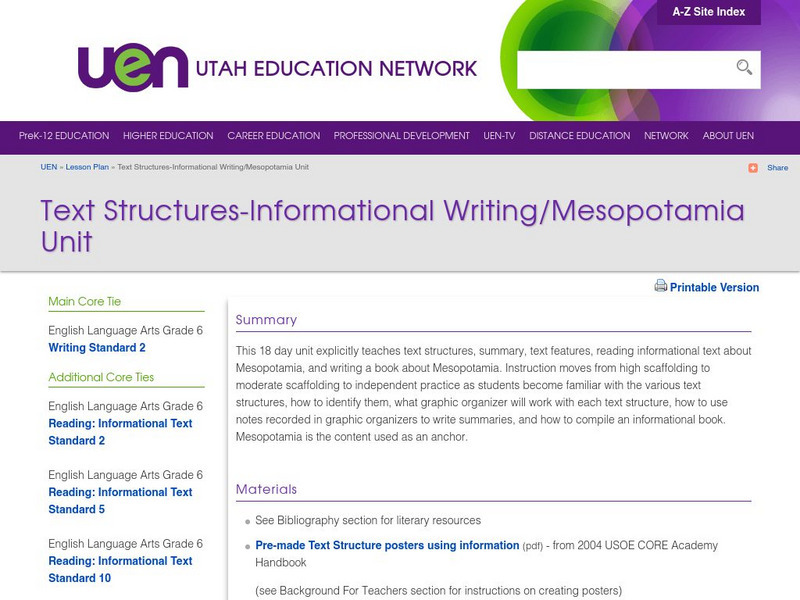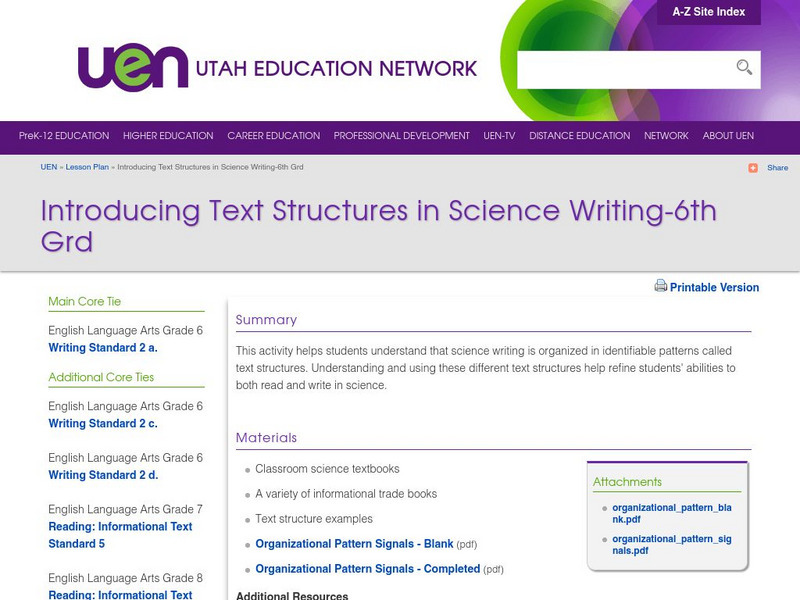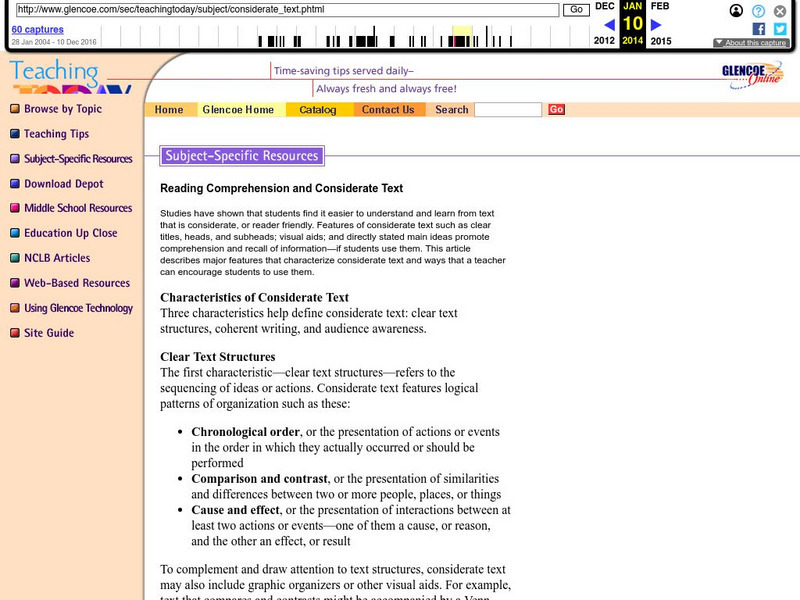Hi, what do you want to do?
Curated OER
Erie Canal: Journey Back in Time
Fourth graders read the novel, The Eric Canal, identifying the characters and setting. They respond to daily reading by writing in journals and complete a short answer test upon completion of the novel.
Curated OER
SCI-FI TALES
Fifth graders brainstorm known features of science fiction books and titles read. They pair up and discuss the possible physical characteristics fo a creature that could appear fron an excerpt of SCI-FI TALES.
Curated OER
Understanding Tyrannosaurus Rex
Students explore the history of the Tyrannosaurus Rex according to the Bible. Students research the size of the Tyrannosaurus Rex. They discuss the T. Rex skeleton "Sue" and the controversy that surrounded it.
Curated OER
Assembling the Best Possible Cabinet
Students organize a list of qualities that a person must have to become a Prime Minister in Canada, and in groups discuss the quality of choices made by each group. They compare/contrast the list with the current Prime Minister.
Curated OER
A Happy Time
Second graders listen to stories about feelings, identify their own feelings at specific times in their lives, and express their feelings in words and through writing.
Curated OER
Things About Me
Learners watch as the teacher explains how to use a storyboard to plan a PowerPoint presentation. They examine how to use clip art, background colors, and at least one transition before creating a PowerPoint presentation according to the...
Curated OER
Have You Ever Wondered?
Young scholars use their personal knowledge and the Internet to discover where and how spiders live. In groups, they discuss their experiences with spiders and how their lives differ from other insects. They use new vocabulary to discuss...
Curated OER
Making Kites
Students engage in the study of kites and focus upon the evaluation and designs invovled. They conduct research into the different types of designs and use the information in order to create unique project designs. The drawings are...
Curated OER
Hearts and Partners
Tenth graders explore, examine and study poetry within a variety of different strategies within this lesson. They review and discuss a diagram of the big picture of why it's importance to study, analyze and deconstruct poetry, so that...
Curated OER
Accountable Terms
Students examine concepts, terms and organizations necessary to explain the basis of a speech by President Bush on corporate responsibility. They read and analyze the speech.
Curated OER
How - To - Posters
Students investigate the skills needed to survive for the early colonial settlers and Native Americans. They conduct research, develop a list of skills, and create a how-to poster demonstrating a survival skill.
Curated OER
What is the Thermal Depolymerization Process?
Students examine the differences between Boyle's Law and Charles' Law. They discuss the concept of thermal depolymerization. They answer discussion questions to end the lesson.
Curated OER
Housing
Young scholars prepare for life on their own after graduation. They explore various types of housing available in the United States. Students study about caring for a home including how to resolve problems and repairs.
Curated OER
Comparing Characters
Young scholars compare similarities/differences of two characters. They demonstrate use of graphing software to compare/contrast their two characters. Students incorporate Inspiration/Kidspiration and the use of a Venn Diagram.
Curated OER
Polythene: Bags Of Trouble
Learners investigate the use of polythene bags in the community and measure the possible impact upon the environment. They conduct research using a variety of resources. The information is used in order to create an evaluative opintion...
Utah Education Network
Uen: Text Structures Informational Writing/mesopotamia Unit
This module provides an 18-day unit about Mesopotamia. Teachers of the unit will explicitly teach students about text structures, summary writing, reading informational texts, and writing a book about Mesopotamia.
Reading Rockets
Reading Rockets: Teach Expository Text Structure to Facilitate Comprehension
Expository text can be challenging to young readers because of the unfamiliar concepts and vocabulary it presents. Discover ways to help your students analyze expository text structures and pull apart the text to uncover the main idea...
Reading Rockets
Reading Rockets: "Seven Strategies to Teach Text Comprehension" by c.r. Adler
In this article, "comprehension strategies" are explained. Supported by research, these strategies are divided into seven different steps, including the following: monitoring comprehension, metacognition, graphic and semantic organizers,...
Utah Education Network
Uen: Lesson Plan: Text Structures in Science Writing
Lesson for teaching students to identify components of scientific texts and to use similar structures in their own scientific writing.
TES Global
Blendspace: Rl5.3 Fables: Analyzing Theme, Story Elements, Text Structure
A six-part learning module with images, graphic organizers, videos, web links and more to teach students how to analyze theme, story elements, and text structure in fables.
Other
Educeri: Compare & Contrast the Overall Structure in Two or More Texts [Pdf]
A 10-page handout that explains clearly what text structure is and four different types, with accompanying examples. Different types are then presented along with two pieces of informational text and a modeled analysis, then two other...
McGraw Hill
Mc Graw Hill: How to Use Strategies to Teach Students to Access Complex Texts
In this short video, the strategies of summarizing, clarifying, and asking-answering questions are used. These instructional tools will help teachers show students how to access complex texts. [5:54] CCSS.ELA-Literacy.CCRA.R.10
Curated OER
Glenco Online: Teaching Today: Reading Comprehension and Considerate Text
Learn the features of "considerate text" and ways to teach students to use these features to increase their comprehension as they read. These features generally apply to non-fiction, especially textbooks.
AdLit
Ad lit.org: Teaching Writing to Diverse Student Populations
Writing is a complex operation requiring knowledge of text structure, syntax, vocabulary, and topic, and sensitivity to audience needs; so it is not surprising that many teens find writing challenging. This article identifies the...


























